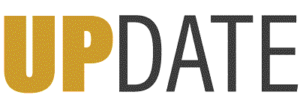By Daniel Burrus
As COVID-19 uncertainty spreads around the world at an exponential pace, the global community is finding out that reacting quickly to the societal and economic disruptions that the virus creates, no matter how agile a reactor you are, is not good enough and quite frankly, is simply not working.
With disruptive changes moving so fast, everything seems to be uncertain, and that uncertainty can cause us all to “wait and see,” which is the exact opposite of what we should be doing now! The only way individuals, entrepreneurs, business and government leaders can get ahead of the spread of the virus, and get control of its speed and devastating impact, is to stop focusing on reacting quickly, or “pivoting,” as some have called it, and start becoming anticipatory by separating the Hard Trends that will happen from the Soft Trends that might happen and can be changed.
You cannot change a Hard Trend, but you can see it coming, and by knowing what will happen before it happens, you can create strategies to take advantage of that trend, giving you certainty and the confidence to make bold moves as you move ahead. Another major advantage of Hard Trends is that they allow you to identify the problems that are ahead and solve them before they occur.
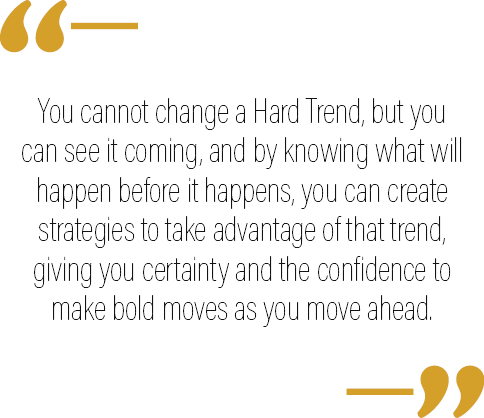
Pandemic Uncertainty Problem
The coronavirus pandemic has leveled the playing field. The exponential uncertainty it brings with it has forced increasing numbers of people to live day-by-day as they try to protect what they have in an effort to combat what might happen as this highly unusual year unfolds.
However, it is important to note that the exponential spread of COVID-19 as it doubles every three days is a Soft Trend, meaning that the exponential spread can be changed! Anticipatory government and business leaders saw the predictable exponential spread of the virus and the potential human and economic impact. They realized it was a Soft Trend that could be changed and took action to slow and eventually stop the spread by closing nonessential businesses and implementing strong social distancing measures in order to flatten the curve, save countless lives, and save millions, billions, and even trillions of dollars.
As we lock down, work remotely and do our best to remain healthy and safe, realize that everyone is hurting and with that, there are enormous new ways to make a bigger difference as you simultaneously grow your business.
So how do you innovate when everyone’s mindset is to wait out the storm? You Go Opposite; take the road less traveled to take your organization from success to significance and turn this pandemic disruption into opportunity.
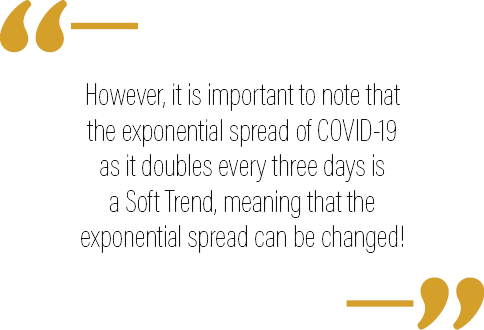
Going Opposite
I’ve written about this anticipatory principle in the past; I call it the Law of Opposites. By looking for a solution to a problem or a new opportunity in the exact opposite direction from where you are currently looking, you will see amazing solutions and opportunities that were outside of your view. From a strategic standpoint, when everyone goes one way, Anticipatory Leaders often go the other and take the road less traveled.
There isn’t a better time to do this! The pandemic and lock downs already are a road less traveled, one in which many will sit on the sidelines and wait and see what will happen. In many ways the world seems to be hitting a pause button as the vast majority goes into a hold position. By doing so, they will not be ready for the identifiable certainty that the pandemic will end.
Many might think that having a wait and see approach is less stressful, but the opposite is true. As you wait, you will see others moving ahead, intuitively knowing that while others are moving ahead, you’re falling behind. The stress of waiting for months will mount, making it harder to start moving again.
I’m sure you have heard the old saying: “an object at rest tends to stay at rest, while an object in motion tends to stay in motion.” Admittedly, it’s hard to move forward when you can’t see ahead. That’s why you should start with the opposite; observe what you can see instead of focusing on what you can’t see. Instead of looking at all the things you aren’t certain about, ask yourself: What are you certain about? Instead of looking at all the things you can’t do, ask yourself: What can you do now? Why not do the opposite while everyone else sits and waits?
Redefine and Reinvent Everything!
This is the perfect time to redefine and reinvent what you do and how you do it. Redefining and reinventing are core principles of Anticipatory Leaders, and as we see, current systems, such as how we deliver healthcare and the global supply chain, buckle under the load. The fault lines in our systems become highly visible and the systems become ripe for reinvention.
The fact is that every system is ripe for reinvention, and the best time to do it is now. When times are good, transformational change can be put off, but when the world and everyone in it is hurting, people are much more open to new, innovative ideas. It’s time to double down on redefining and reinventing your products, services and customer experiences before someone else does, and if you do this while helping others through the crisis, you will find a lot more help along the way!
Focus on Becoming a Positive Disruptor
The news, which has been quite dark lately, is focused on the virus, what it has done and is doing. It’s imperative to look beyond the news and to look ahead at what we do know!
I would like you to consider becoming a positive disruptor, creating the transformations that need to happen to make the future better for everyone. This is not as hard as it seems, because perfection is impossible; everything can be improved. Everything has facets to it that can be changed for the better. A positive disruptor has the power to unite people and help humankind move forward in a positive and productive way.
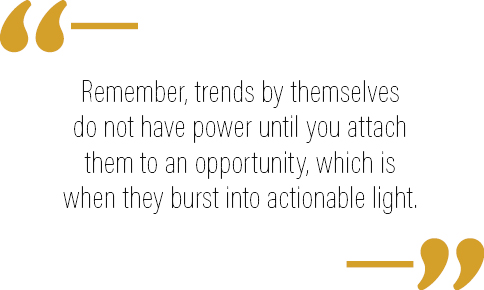
A New Beginning
In this new year, new decade and global pandemic, where do you start? It’s simple; find certainty by identifying the Hard Trends that will happen and the related opportunities to move forward. Remember, trends by themselves do not have power until you attach them to an opportunity, which is when they burst into actionable light. And positive disruptors use Soft Trends to their advantage, because they can change them if they’re undesirable.
When everyone is stuck in one mindset, go opposite! If you anticipate instead of reacting, redefine and reinvent instead of waiting, move forward instead of standing still, and focus on significance over success, you will put yourself and your organization much further ahead than ever before.
In this time of unprecedented uncertainty, actively shaping your future by becoming an Anticipatory Leader has never been more important.

Hard Trends — Easier to Identify Than You Think
A well-worn cliché says there are only two things you can be certain about: death and taxes. With apologies to those who agree with that statement, there are many, many more examples of out-and-out certainties. Was Sunday followed by Monday last week? Absolutely. Will that be the case next week? You can count on it.
A more timely and, in some ways, comforting example involves the ever-changing situation we find ourselves in today with COVID-19. This pandemic has seemingly pressed pause on time, stifling businesses in many ways and rattling humankind as we’re told that each day is fluid, and we’re not sure what the next day will bring. Monday will still follow Sunday, but will it be business as usual? Right now, the answer is no.
But, if Hard Trends, or future certainties, are as easy to identify as I maintain, what is the Hard Trend in all of this? It’s as obvious as my days-of-the-week anecdote above: This virus will end, and that is a fact that will happen. Because of this, you better believe that, aside from the length of the coronavirus’s impact, there are still Hard Trends in every industry, plus plenty of opportunity in the disruption that is this global pandemic.
In order to be able to identify Hard Trends during these unprecedented times, we must diagnose the very concept of Hard Trends and how they can lead to significant game-changing opportunities for you and your organization.
What’s a Hard Trend?
As previously stated, a Hard Trend is a future certainty, in that it is something we know is going to occur whether we want it to or not. Opposite of Hard Trends are Soft Trends, which are future possibilities that may or may not take place. In the case of Soft Trends, these can be changed to your, and your organization’s, benefit.
To further explore my Hard Trend Methodology and how it can help you be more anticipatory during times like we currently face, I have grouped Hard Trends into three primary categories for identification purposes.
Demographics. This can be age, race, gender, or any other defining characteristic of a group. During this pandemic, an example is an older generation like the Baby Boomers. The fact that they are more susceptible to COVID-19 is a definite Hard Trend.
Government Regulations and Oversight. For this category, a broad question immediately comes to mind: As a general rule, will there be more or less government regulation in the future? If we’ve learned anything from the coronavirus pandemic, it is that there will definitely be more. As new innovations emerge amid the lockdown, new governmental regulations will evolve in response to them. This is true, regardless of the industry or organization, making this a Hard Trend.
Technology. From the ever-increasing accessibility of 3D printing to holographic telepresence, technology is inevitably going to become more functional, more sophisticated and more widespread. In addition to how we have learned to use already-existing technology during the pandemic, this makes technology in any capacity a Hard Trend; we will always be finding a newer, better way to accomplish a task or create something.
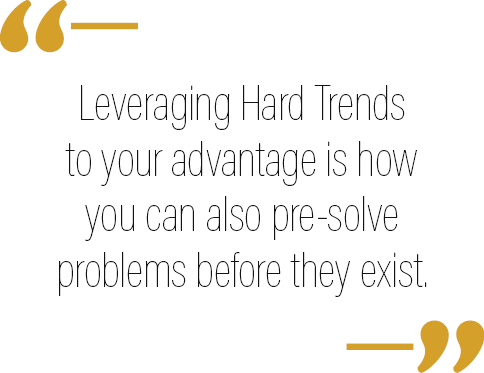
Why Hard Trends Matter
Knowing that something is a future certainty means so much more in times like these. It’s central to your organization’s planning and subsequent execution of innovation, even during an economic shutdown.
In terms of government regulation, coupled with the ever-changing spectrum of this pandemic and subsequent lockdown, being aware of the Hard Trend of growing government regulation allows you to become more anticipatory with those additional guidelines foremost in your mind, allowing you as an organization to continue to progress and grow.
Leveraging Hard Trends to your advantage is how you can also pre-solve problems before they exist. Case in point: When the United States government mandated a stay-at-home order, closing the physical operations of many nonessential businesses, many threw up their hands in frustration, while others decided to adapt and overcome, taking advantage of opportunities to continue to operate during a shutdown — and profited accordingly.
What you can expect is that Hard Trends — identified and acted upon — can offer enormous opportunities for those organizations with the mindset of always keeping their eyes open to the future.

Use Soft Trends to Influence the Future
There are certain things about the future that we simply can’t change. Some are rather obvious. For instance, spring will always follow winter. New Year’s Day will always be January 1, at least in many parts of the world. Those are chronological certainties.
There are other future certainties that have nothing to do with the calendar. For example, are the phones we use in the future going to be capable of doing more or less? Of course, they’ll be able to do more. That’s a certainty.
But what about those things that aren’t quite so cast in stone? For instance, will it be colder tomorrow than today? No one can say for certain. Will the stock market rise or fall? Your guess is as good as mine.
The Definition of Soft Trends
Although events that lack certainty may be unnerving to some, I absolutely love them. I call them Soft Trends, and they are a central principle of the overall Anticipatory Organization Model.
Soft Trends are future maybes: those events, developments and other things that may or may not take place.
As I mentioned earlier, one of the greatest appeals of Soft Trends is that they can be changed. They can be altered and, depending on what you know about them and how you use them, they are open to influence, leverage and ultimately, enormous opportunity.
Further, there are positive Soft Trends as well as negative Soft Trends — in so many words, those trends that you want to maintain and build on and those that you may wish to reverse.
For instance, one Soft Trend is the growing number of students furthering their education through online learning. That’s certainly a good thing and a Soft Trend that you may like to nurture and possibly leverage.
By the same token, the number of obese people continues to increase — a Soft Trend, and a negative one at that. In looking to influence this Soft Trend, you’d likely investigate ways to try to reverse this disturbing health pattern.
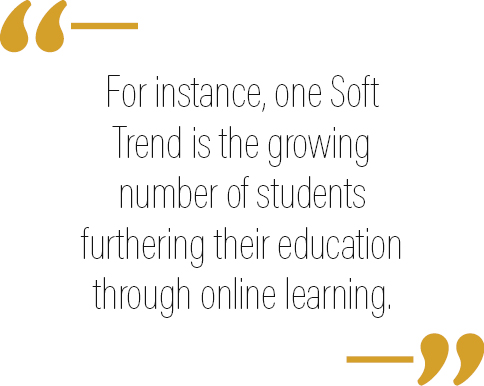
Hard and Soft Assumptions
Another component to Soft Trends is the assumption that underlies them. On one hand, there are Hard Assumptions — defined, empirical data and information. Soft Trends supported by Hard Assumptions are more likely to happen.
For instance, rising health care costs in the United States is a Soft Trend, but one supported by Hard Assumptions — decades of data detailing steady increases in costs. That makes it more likely to continue in the future.
On the other hand, Soft Trends underscored by Soft Assumptions are less likely to occur. Moreover, treating them as though they offer greater certainty than they do can be a dangerous misstep.
For example, when the Affordable Care Act (ACA) was implemented, there was a Soft Assumption that there would be enough young people signing up to offset the higher costs of older participants. One problem: There was no comprehensive research in place to support that — one of many Soft Assumptions that had an adverse effect on the ACA’s launch.
The Need to Carefully Identify Soft Trends
Paying attention to Soft Trends can unlock enormous opportunity for you and your organization.
But the caveat is first recognizing the difference between Soft Trends and Hard Trends, which are future certainties. The simplest explanation is, if you have to think about it, it’s a Soft Trend. Hard Trends are generally obvious at first glance.
Moreover, it’s critical to separate Soft Trends that are driven by Soft Assumptions from those underscored by Hard Assumptions. Even though Soft Trends are never a future fact, they carry a far greater level of confidence when they are associated with Hard Assumptions. A Soft Trend with a Soft Assumption, on the other hand, could be much less of a sure thing.
You can see that Soft Trends offer enormous opportunity if you know how to identify them and with what level of confidence you can use them to your advantage. So, with that in mind, what Soft Trends can you pinpoint that will impact you, your organization or your entire industry?
Daniel Burrus is considered one of the world’s leading futurist speakers on global trends and disruptive innovation. The New York Times has referred to him as one of the top three business gurus in the highest demand as a speaker.
He is a strategic advisor to executives from Fortune 500 companies helping them to develop game-changing strategies based on his proven methodologies for capitalizing on technology innovations and their future impact. He is the author of seven books, including The New York Times and Wall Street Journal bestseller Flash Foresight, as well as the international bestseller Technotrends. His latest book, The Anticipatory Organization: Turn Disruption and Change Into Opportunity and Advantage , is an Amazon #1 Hot New Release for Business.
This story appears in Pub 1 2019-20 Issue 4 of the UPDATE Magazine.
